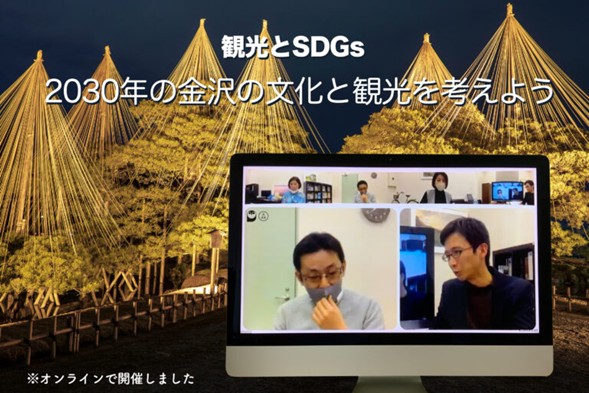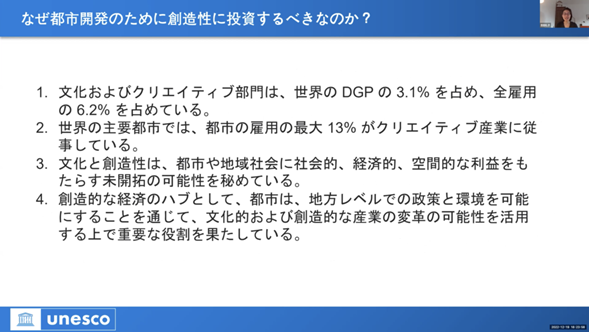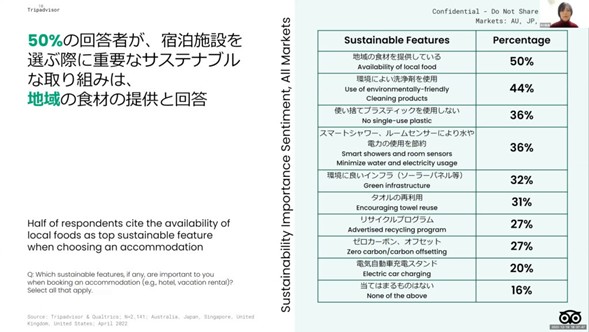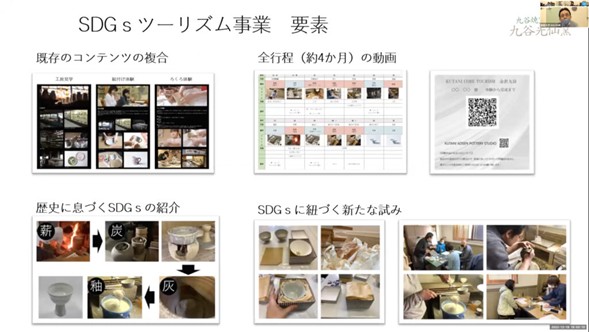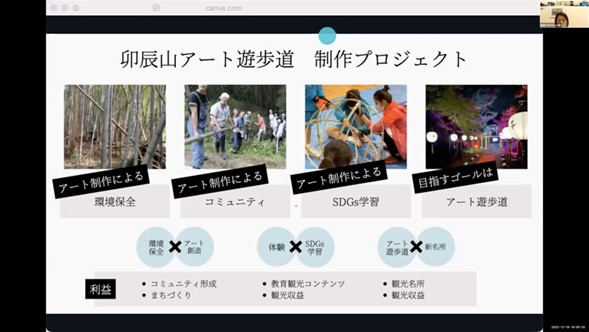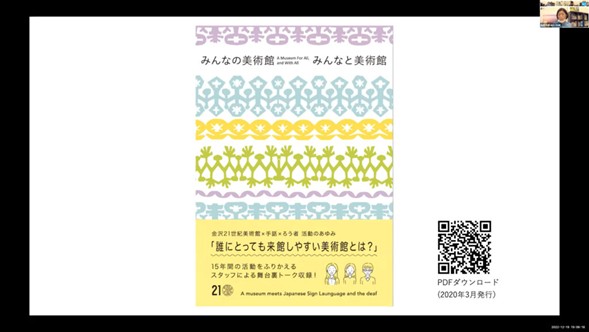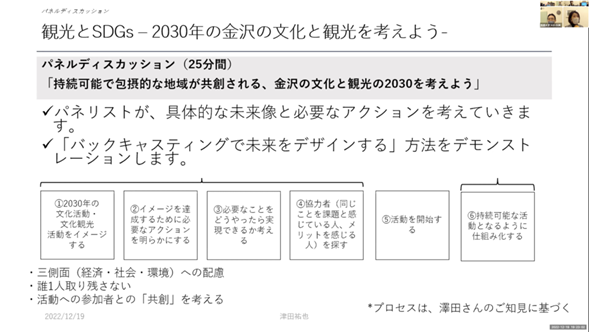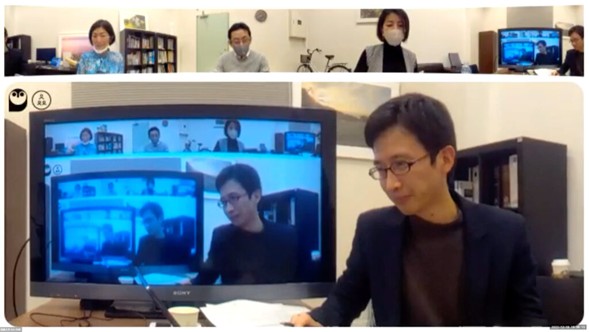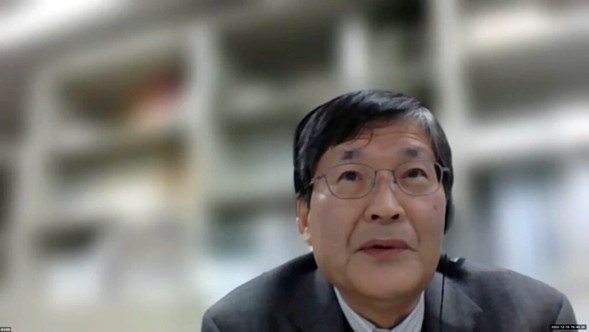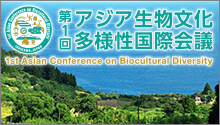This seminar series has focused on sustainable tourism from the perspective of the destination, aiming to deepen our understanding of the connection between tourism and the SDGs, as well as the harmony between tourism and local communities.
This fourth session delved into the relationship between culture, tourism, and the SDGs.
While “culture” is an essential element that shapes society, it is not explicitly defined as a goal within the SDGs. However, it plays a crucial role in advancing the “2030 Agenda” and there are clear connections between individual cultural activities and the SDGs. For instance, promoting diverse cultural activities while respecting different cultures contributes to sustainable tourism and fosters sustainable community development.
What is the relationship between culture, tourism, and the SDGs?
To kick off the session, Yuya Tsuda, a research fellow at the United Nations University IAS OUIK, posed the question, “What is culture?” He then highlighted current challenges concerning the theme of “Culture × Tourism × SDGs.”
Next, Reiko Yoshida from UNESCO’s Culture Sector discussed the development of the cultural industry and its ties to the SDGs. Satomi Nakagawa, an account executive from TripAdvisor, shared insights about the sustainability awareness of international travelers.
Yoshida, joining us all the way from Paris, where excitement was still high after the FIFA World Cup final, spoke on “The Sustainable Development of Cultural and Creative Industries in Local Communities and Their Contribution to the SDGs.” She emphasized the importance of leveraging cultural strength to foster sustainable industries and local development.
She pointed out, “Like sports, culture has the power to unite people’s hearts. It connects diverse individuals through various cultural expressions.” Yoshida explained that the SDGs linked to culture and the creative industries span Goals 4, 5, 8, 10, 16, and 17. She also highlighted the significant impact of the creative industry on the global economy, contributing greatly to GDP and employment, while noting that culture and creativity can bring social, economic, and spatial benefits to urban and rural communities.
Following this, Nakagawa presented findings from a consumer survey conducted across five countries—Australia, Japan, Singapore, the UK, and the US—regarding global travelers’ awareness of sustainable tourism.
Many travelers showed a strong interest in sustainable practices, particularly in consuming local foods and products. She noted, “Incorporating local products into travel packages attracts sustainability-conscious travelers and supports the preservation of local economies and cultures.”
Although only a small percentage have paid more for sustainable experiences, 65% are considering taking action in the future.
Nakagawa also shared that today’s travelers are seeking immersive experiences, like unique dining and learning about local history and culture. She emphasized the importance of crafting narratives around lesser-known experiences that complement popular tourist spots, urging communities to collaborate in storytelling.
Three case studies from Kanazawa relating to culture and tourism
Three case studies from Kanazawa relating to culture and tourism were then presented by Koichiro Torioka of Kutani Kosen Kiln, Masami Sawada of KanazaWAZA Institute, and Kumiko Kibi of the 21st Century Museum of Contemporary Art in Kanazawa.
The Kutani Kosen Kiln, with a history of about 150 years, is involved in promoting Kanazawa’s SDGs tourism initiative. Torioka discussed how SDGs are inherent to Kanazawa’s culture and history, expressing that they should be utilized for evaluation, selection, and course correction.
Sawada outlined two approaches to fostering interest in traditional culture—through “traditional shows” and the development of the Utatsuyama Art Trail project based on folk culture. He explained that the project addresses the issue of abandoned bamboo forests by creating the “Art Trail” tourist attraction through the collaboration of the local community and visitors.
The 21st Century Museum of Contemporary Art in Kanazawa, opened in 2004 with the concept of “a park-like museum open to the city,” aims to create new cultural experiences and invigorate the community.
Under the theme “A Museum for Everyone, With Everyone,” initiated in 2018, the museum seeks to become a more inclusive space. It aims to function as a community within a diverse society while engaging with various groups, continuously experimenting and collaboratively envisioning a shared future.
How should culture and tourism evolve in Kanazawa by 2030?
This question led to a panel discussion featuring the three speakers. Several key points emerged during the discussion:
“Instead of pondering how to promote our culture or how to link it to tourism, it’s more important to first envision the future we want to achieve, much like the principles of the SDGs.” (Sawada)
“By 2030, we hope to see a greater number of cultural bearers who will actively help create new communities. It would be ideal if tourism could serve as a tool in this process. I’d like to hear your thoughts on how we can make this a reality.” (Tsuda)
The lack of successors can be attributed to economic reasons, but a significant factor is also the pride that motivates them to continue. If the culture itself does not possess enough charm to inspire such pride, the younger generation will not step up as successors. (Toshioka)
To preserve the culture of Kanazawa, whose support is essential? Visitors who come to Kanazawa for tourism should be regarded as potential successors, and through their experiences, we can nurture a desire among them to continue the culture of Kanazawa. Tours that inspire this feeling are also emerging. The first step is to spark interest in the culture itself. (Sawada)
The nature of tourism is changing, with tourists increasingly seeking to engage in a way that positively impacts the local community. They are more inclined to visit places where their actions can contribute positively to the area, rather than just being passive observers. (Toshioka)
Having multiple universities in the city is beneficial when considering the future. (Yoshibi-san)
To conclude the seminar, Tsunao Watanabe, Director of the United Nations University IAS OUIK, remarked, “Each region has its own unique natural environment, and the culture of each area has developed in relation to that nature (biocultural diversity). By reflecting on these regions together and effectively intertwining nature and culture, we can unlock the key to creating distinctive communities, which is also a crucial point for sustainable tourism.”


